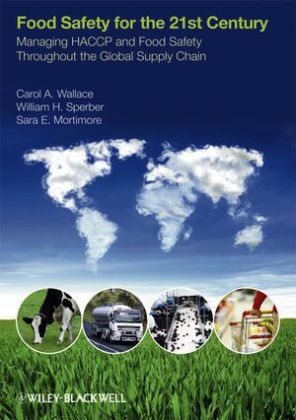Fr. 262.00
S. Mortimore, Sara E. Mortimore, William Sperber, William H. Sperber, Carol Wallace, Carol A. Wallace...
Food Safety for the 21st Century - Managing Haccp and Food Safety Throughout the Global Supply Chain
Englisch · Fester Einband
Versand in der Regel in 1 bis 3 Wochen (kurzfristig nicht lieferbar)
Beschreibung
* Provides a practical and up-to-date text covering the essentials of food safety management in the global supply chain, giving the reader the knowledge and skills that they need to design, implement and maintain a world-class food safety programme.
Inhaltsverzeichnis
Preface.
Acknowledgements.
Disclaimer.
How to use this book.
The authors.
Glossary of terms and acronyms.
PART ONE: FOOD SAFETY CHALLENGES IN THE 21ST CENTURY.
1 Origin and evolution of the modern system of food safety management: HACCP and prerequisite programmes.
1.1 Historical perspectives.
1.2 Origin and evolution of HACCP.
1.3 The necessity of prerequisite programmes.
1.4 The future of HACCP.
2 Lessons learned from food safety successes and failures.
2.1 Introduction.
2.2 Benefits of using HACCP - lessons learned from successful implementation.
2.3 Misconceptions or 'failure to understand HACCP'.
2.4 Barriers to effective HACCP use.
2.5 Reasons for failure.
2.6 Difficulties with applying HACCP through the entire food supply chain.
2.7 Roles and responsibilities - lessons learned.
2.8 Conclusions.
3 Food safety challenges in the global supply chain.
3.1 Introduction.
3.2 Increased complexity of the global supply chain.
3.3 Food safety issues in global trade.
3.4 Strategic-level responses.
3.5 Tactical level responses.
3.6 Conclusions.
4 The future of food safety and HACCP in a changing world.
4.1 Introduction.
4.2 Food safety issues.
4.3 Technology advancements.
4.4 Food safety management.
4.5 Changes in thinking/policy making.
4.6 Conclusions.
PART TWO: FOODBORNE HAZARDS AND THEIR CONTROL.
5 Recognising food safety hazards.
5.1 Introduction.
5.2 Biological hazards.
5.3 Chemical hazards.
5.4 Physical hazards.
5.5 Conclusions.
6 Designing safety into a food product.
6.1 Introduction.
6.2 Formulation intrinsic control factors.
6.3 Use of experimental design and analysis.
6.4 Ingredient considerations.
6.5 Conclusions.
7 Designing a safe food process.
7.1 Introduction.
7.2 Process control of microbiological hazards.
7.3 Process control of chemical hazards.
7.4 Process control of physical hazards.
7.5 Conclusion.
PART THREE: SYSTEMATIC FOOD SAFETY MANAGEMENT.
8 Overview of a world-class food safety programme.
8.1 Introduction.
8.2 Preliminary concepts and definitions.
8.3 World-class food safety programmes in the global food supply chain.
8.4 Continuous improvement of the world-class food safety programme.
8.5 Conclusions.
9 Building the foundations of a world-class food safety management programme: essential steps and practices.
9.1 Introduction.
9.2 Essential management practices.
9.3 Preparation activities for food safety programmes.
9.4 Prioritisation of corrective actions.
9.5 Conclusions.
10 Formalised prerequisite programmes in practice.
10.1 Introduction.
10.2 Prerequisite definitions and standards.
10.3 Prerequisite programmes - the essentials.
10.4 Prerequisite programmes and operational prerequisites.
10.5 Validation and verification of prerequisite programmes.
10.6 Conclusions.
11 Conducting a product safety assessment.
11.1 Introduction.
11.2 Training for research and development personnel.
11.3 Example of a product safety assessment.
11.4 Conclusions.
12 Developing a HACCP plan.
12.1 Introduction.
12.2 Preliminary concepts.
12.3 Applying the codex logic sequence to develop a HACCP plan.
12.4 Conclusions.
13 Implementing a HACCP system.
13.1 Introduction.
13.2 Activities for implementation of a HACCP plan.
13.3 Considerations for implementing updates and changes to an existing HACCP system.
13.4 Conclusions.
14 Maintaining a food safety programme.
14.1 Introduction.
14.2 What is food safety programme maintenance?
14.3 Responsibility for food safety programme maintenance.
14.4 Maintenance of prerequisite programme elements.
14.5 Maintenance of HACCP system elements.
14.6 Use of audit for successful food safety system maintenance.
14.7 Incident Management.
14.8 Conclusions.
References.
PART FOUR: APPENDICES.
Appendix 1: HAC
Bericht
"Authors Sara Mortimore, Carol Wallace and William Sperber provide practical, up-to-date
coverage on the essentials of food safety management in the global supply chain ... This book provides information relevant to all sectors and sizes of food businesses throughout the world, clearly outlining how the foundations of a world-class food safety management programme can be built." (On the Bookshelf, 2011)
"I highly recommend the work and consider it an essential addition to the personal library of scientists, managers, educators, academic researchers, and students working to understand and advance food safety on a world scale." (Journal of Aquatic Food Product Technology, 23 August 2012)
Produktdetails
| Autoren | S. Mortimore, Sara E. Mortimore, William Sperber, William H. Sperber, Carol Wallace, Carol A. Wallace, Carol A. Sperber Wallace, Carol Sperber Wallace |
| Verlag | Wiley, John and Sons Ltd |
| Sprache | Englisch |
| Produktform | Fester Einband |
| Erschienen | 26.11.2010 |
| EAN | 9781405189118 |
| ISBN | 978-1-4051-8911-8 |
| Seiten | 352 |
| Thema |
Naturwissenschaften, Medizin, Informatik, Technik
> Medizin
> Allgemeines
|
Kundenrezensionen
Zu diesem Artikel wurden noch keine Rezensionen verfasst. Schreibe die erste Bewertung und sei anderen Benutzern bei der Kaufentscheidung behilflich.
Schreibe eine Rezension
Top oder Flop? Schreibe deine eigene Rezension.

